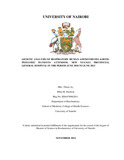| dc.contributor.author | Mbui, Fredrick M | |
| dc.date.accessioned | 2014-12-01T09:56:04Z | |
| dc.date.available | 2014-12-01T09:56:04Z | |
| dc.date.issued | 2014 | |
| dc.identifier.citation | Masters of Science in Biochemistry | en_US |
| dc.identifier.uri | http://hdl.handle.net/11295/75769 | |
| dc.description.abstract | Human adenoviruses (HAdVs) are common pathogens associated with diseases affecting
the respiratory tract, gastro-intestinal tract as well as various organs like the liver, kidney
and the brain. Currently there are 60 human adenovirus serotypes classified into 7 species
A to G on the basis of serology, genome sequencing and phylogenomics. HAdV species
B, C and E are mainly implicated in respiratory tract infections whereas the other species
are associated with gastro-intestinal, genitourinary, and ocular infections. The respiratory
HAdV species play a significant role in pediatric infections accounting for 10% of overall
respiratory illnesses and 5%–11% of pneumonia cases. The burden of diseases due to
respiratory adenoviruses in Kenya has not been studied. There is no documented data on
respiratory human adenovirus species and serotypes circulating in the country.
The aim of this study was to characterize respiratory human adenoviruses using
serological and molecular approaches. Specifically the study sought to determine the
species and serotypes of HAdVs that were associated with pediatric respiratory infections
in New Nyanza Provincial General Hospital in the period of June 2010 to June 2012.
HAdVs were isolated from 16 archived nasopharyngeal swab patient specimens after
inoculation into cultured Hep2 cells. After cytopathic effect observation, presence of
adenovirus was confirmed through immunofluorescence assay. Virus DNA was extracted
from the isolates followed by PCR amplification of the hyper-variable region 7 located in
loop 2 region of hexon gene. The amplicons were sequenced using the Sanger dideoxy
termination method followed by bioinformatics analyses of the nucleotide sequences.
The hexon nucleotides sequences were used to classify the HAdV isolates into various
species and serotypes by use of phylogenomics.
Nucleotide sequences of hexon loop-2 fragment of approximately 500 base pairs were
obtained. Multiple sequence alignment of the loop-2 sequences with reference sequences
obtained from other parts of the world revealed the location of the hyper-variable region
at 1330-1400bp; a region characterized by several nucleotide substitutions, insertions and
deletions. Phylogenomics analysis showed that during the study period, respiratory
HAdV species B and C were associated with respiratory infections among pediatric
patients attending New Nyanza Provincial General Hospital accounting for
approximately 1% of the overall respiratory viruses. There were no cases of infections
caused by respiratory HAdV E implying that this species was not in circulation during the
study period. HAdV C was the predominant species accounting for 68.75% of the
reported cases with serotype distribution as HAdV C1-25%, HAdV C2-25%, HAdV C56.25%,
and HAdV C6-12.5%. HAdV B serotype 7 was the most prevalent serotype at
31.25%. HAdV C5 and HAdV B7 sequences were found to be under positive selection
pressure indicating that these viruses are undergoing an evolutionary process which
signifies instability in their genomes.
Characterization of respiratory human adenoviruses that circulated at New Nyanza
Provincial General hospital during the study period revealed that species B and C were
present but not E. There was significant genetic variation in the hexon gene of the
HAdVs seen at this site compared to those from other parts of the world implying
continuing evolution of respiratory HAdVs. To gain a complete understanding of this
evolutionary process, whole genome sequencing of these viruses is called for in order to
determine genetic stability and uniqueness of these viruses. | en_US |
| dc.language.iso | en | en_US |
| dc.publisher | University of Nairobi | en_US |
| dc.title | Genetic analysis of respiratory human adenoviruses among pediatric patients attending new nyanza provincial general hospital in the period june 2010 to june 2012 | en_US |
| dc.type | Thesis | en_US |
| dc.description.department | a
Department of Psychiatry, University of Nairobi, ; bDepartment of Mental Health, School of Medicine,
Moi University, Eldoret, Kenya | |
| dc.type.material | en_US | en_US |

